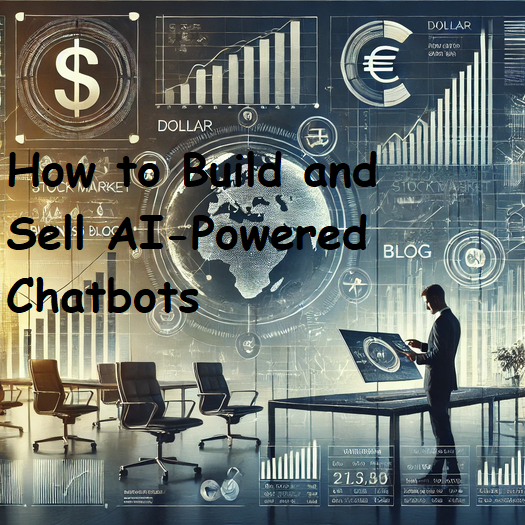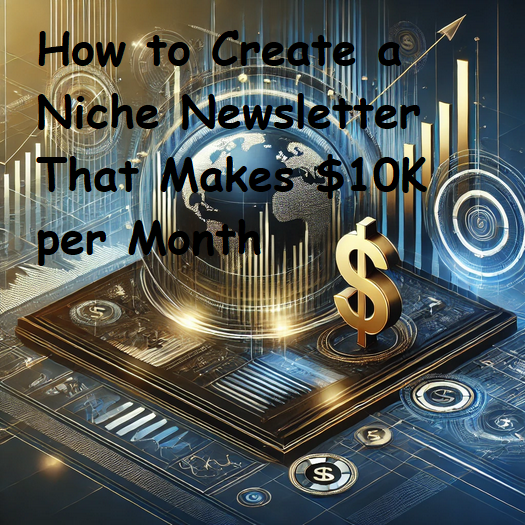How to Build and Sell AI-Powered Chatbots
This article covers the step-by-step process of building and selling AI-powered chatbots as a profitable business. It explains the essentials of AI chatbot technology, how to create effective and engaging bots, and strategies for selling them to businesses in need. Whether you’re a tech novice or an experienced developer, this guide will walk you through the process of developing chatbots that solve real business problems, and how to make money by selling them.
Introduction:
Why Build AI-Powered Chatbots?
AI-powered chatbots are transforming the way businesses interact with their customers. These bots can provide instant responses, 24/7 support, and handle repetitive tasks like answering frequently asked questions, processing orders, or offering personalized recommendations.
The demand for chatbots is growing across various industries, including e-commerce, healthcare, finance, and customer service. Entrepreneurs and developers are jumping on the opportunity to build and sell chatbots as a service, creating a profitable business model with the potential for significant passive income.
So, how do you get started building and selling AI-powered chatbots? Let’s break it down.
1. Understand the Basics of AI Chatbots
Before jumping into building chatbots, it’s essential to understand how AI chatbots work and what they can do for businesses.
What is an AI-Powered Chatbot?
An AI-powered chatbot is a software application that uses Artificial Intelligence (AI) and Natural Language Processing (NLP) to simulate human-like conversations with users. Chatbots can:
- Answer questions in real-time.
- Assist with customer service inquiries.
- Process transactions or bookings.
- Guide users through complex workflows.
Chatbots use machine learning algorithms to improve over time and provide more accurate responses, making them extremely valuable to businesses looking to enhance customer experience.
Types of AI Chatbots
- Rule-Based Chatbots – These are limited to predefined responses based on specific commands or keywords.
- Intelligent Chatbots – These use machine learning and NLP to understand context and provide more conversational and dynamic responses.
2. Choose Your Niche
Not all chatbots are created equal, so identifying the right niche is key to building a successful business. Focus on solving specific problems within particular industries. Here are a few profitable niche ideas:
- Customer Support Bots – Automate customer service for businesses in e-commerce, SaaS, or hospitality.
- E-commerce Chatbots – Help online stores with product recommendations, order tracking, and FAQs.
- Healthcare Bots – Answer patient queries, provide appointment scheduling, or send medication reminders.
- Lead Generation Bots – Capture leads for businesses by automating the qualification process and scheduling meetings.
- Finance Bots – Provide financial advice, send market updates, or help with loan applications.
Focusing on a niche helps you tailor your chatbot to solve specific problems and increases the likelihood of selling it to businesses in that field.
3. Build Your AI Chatbot
Now that you know what type of chatbot you want to build and who your target market is, it’s time to start creating. Here’s a simple roadmap to guide you through the process:
Step 1: Choose the Right Tools and Platforms
You don’t have to be a coding expert to build an AI-powered chatbot. There are several platforms and tools available that can help you create a bot without needing extensive programming skills.
- Dialogflow (by Google) – A powerful tool for building conversational AI with easy integration into other platforms.
- IBM Watson – A robust chatbot builder with NLP and machine learning capabilities.
- Tars – A no-code chatbot builder focused on automating lead generation and customer support.
- ManyChat – Focuses on building bots for social media platforms like Facebook Messenger and WhatsApp.
- Chatfuel – Another user-friendly tool for creating bots for Facebook Messenger and other social media.
Step 2: Define Bot’s Purpose and Goals
Before you start designing your chatbot, clearly define its purpose and objectives. Is the bot for customer service, product recommendations, lead generation, or something else?
Step 3: Develop Conversational Flow
Plan the chatbot’s conversation flow. Define how the bot will respond to different queries, handle edge cases, and guide users through the process. You can create simple flowcharts or wireframes to outline this process.
Step 4: Train Your Bot
AI chatbots improve by learning from past interactions. Use machine learning and NLP to help the bot understand and adapt to user queries over time.
Step 5: Test and Optimize
Once your bot is ready, thoroughly test it to ensure it provides accurate responses and flows smoothly. Try to identify weak points and optimize the conversations to improve user experience.
4. Sell Your AI Chatbots
After building your AI chatbot, the next step is to sell it. Here’s how to approach the sales process:
Step 1: Find Potential Clients
Your target clients are businesses or organizations looking to automate customer interactions or improve their digital experience. Focus on industries like:
- E-commerce – Shopify stores, Amazon sellers, etc.
- Real Estate – Agents who need lead qualification bots.
- SaaS Companies – To provide customer support bots.
- Healthcare Providers – Clinics and doctors who need appointment scheduling bots.
- Education – Schools or online courses that can automate enrollment.
You can approach these businesses directly or use platforms like Upwork, Fiverr, or Freelancer to offer your chatbot services.
Step 2: Create a Portfolio
To showcase your expertise, create a portfolio that includes demos of your chatbots. Use a website or a platform like GitHub or Behance to share your work. The more examples you have, the easier it will be to attract clients.
Step 3: Pricing Your Chatbots
Pricing will depend on the complexity of the bot and the businesss needs. Here are some common pricing models:
- One-Time Fee – Charge a flat fee for the design and deployment of the chatbot.
- Subscription Model – Offer continuous support, updates, and monitoring for a monthly fee.
- Customization Fee – If the business requires specific customization, charge additional fees.
5. Market and Scale Your AI Chatbot Business
Step 1: Build an Online Presence
Market your chatbot business by building a strong online presence:
- Create a website showcasing your services and portfolio.
- SEO your site with relevant keywords like "AI chatbot for e-commerce" or "automated customer service chatbot."
- Leverage social media platforms like LinkedIn, Twitter, and Facebook to promote your services.
Step 2: Use Testimonials and Case Studies
When you’ve completed your first few chatbot projects, ask clients for testimonials or create case studies to highlight the results you delivered. This builds trust and credibility with potential buyers.
Step 3: Expand Your Offerings
As your business grows, consider scaling your chatbot services by:
- Offering chatbot maintenance and updates to ensure the bots continue to perform optimally.
- Building chatbot bundles that include multiple bots designed for different functions or industries.
- Creating a chatbot template library that businesses can purchase and customize on their own.
6. Conclusion: Start Building and Selling AI-Powered Chatbots
AI-powered chatbots are in high demand, and with the right strategy, you can build and sell chatbots to businesses in need of automation. Whether you’re offering a simple FAQ bot or a sophisticated customer service assistant, there’s a massive opportunity to tap into this growing market.
By understanding the tools, defining a profitable niche, and using effective marketing techniques, you can turn building AI-powered chatbots into a thriving business that provides value to your clients and generates consistent revenue for you. So, start building your chatbot today and make money solving real business challenges.





 Account.png)









.jpg)


